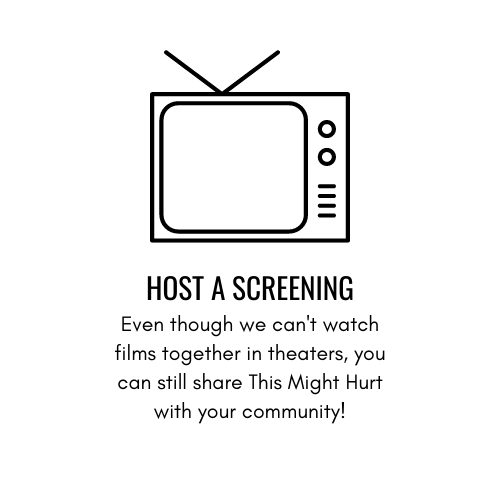THE PROBLEM: CHRONIC PAIN
Over 50 million Americans suffer from chronic pain, and nearly 80% of us will experience it at some point in our lives. The symptoms show up as back pain, neck pain, fibromyalgia, migraines, irritable bowel syndrome, anxiety, depression, and a dozen others. The standard treatments are failing, and one of the main remedies, opioids, has only made the problem worse. What’s going on here?
the film
This Might Hurt is a documentary that offers solutions to cure chronic pain. The film follows three chronic pain patients who have spent years trying to cure their illness through modern medicine. Desperate for relief, they enter a new, science-based medical program — run by Dr. Howard Schubiner — that focuses on uncovering hidden causes of pain, and retraining their brains to switch the pain off.
While only a handful of doctors are aware of the treatment shown in this film, it’s quickly gaining recognition. Known as “EAET” (Emotional Acceptance and Expression Therapy), the treatment was featured on NPR, shown to be effective in a large randomized controlled trial, and recommended as a “pain management best practice” by the NIH’s task force to combat the opioid epidemic. This Might Hurt provides an in-depth exploration of this cutting-edge treatment, and suggests a path to healing for millions.
Here is a list of just some of the conditions that can be caused by brain-induced pain.
NEWS
Dr. Howard Schubiner and This Might Hurt were featured this week on CBS’s “The Doctors.” Click the image to view the 7-minute segment
Director Kent Bassett and Dr. Schubiner were featured on CBS-8 San Diego.
What people are saying about this might hurt
5 steps TO UNLEARNING CHRONIC PAIN EXPLORED IN THE FILM
1. Get an accurate diagnosis.
Every day doctors make errors in diagnosing chronic pain. They often identify normal MRI findings like degenerative or herniated discs—which are normal signs of aging like grey hair or wrinkly skin—as the cause of pain. Or they make diagnoses like CRPS or IBS or fibromyalgia that merely describe a collection of symptoms but not the cause. This film demonstrates what careful investigation looks like.
2. Understand MOST chronic pain is reversible.
The latest neuroscience is clear that chronic pain can be a learned condition, created in the brain, and can be reversed through a process of neuroplasticity. Clinical medicine has been slow to recognize these findings.
Many chronic pain patients feel their body is broken and that recovery is impossible. They’ve seen countless doctors, tried hundreds of treatments. They’ve been warned by doctors their bodies and brains will never be “normal” again. Even many health professionals believe their patients’ best hope is for better pain management and coping. Dr. Schubiner and the Emotional Acceptance Therapy adamantly reject this framework. Chronic pain, for many, can be dramatically reduced and often eliminated.
3. DEACTIVATE the Fear-Pain Cycle.
Excruciating, unending pain naturally leads to fear, which in turn makes pain worse. This amplification of pain by worrying becomes a vicious cycle. Learn techniques to de-activate fear and understand pain better. When pain is recognized as a danger signal—and not as a sign of worsening tissue damage—it causes less fear, and the cycle can be reversed, leading to less and less pain. Transforming fear-of-pain is a key step to recovery. Fear reduction techniques also go by the terms “somatic tracking” and “pain reprocessing therapy.”
4. Do EMOTIONAL PROCESSING.
Persistent pain can often be caused by underlying patterns of emotional conflicts that are the result of normal childhood stress, and in some cases, trauma or abuse. Physical trauma can also lead to pain that lasts long after the body parts have healed, which brings its own emotional stress. Dr. Schubiner often tells his patients, “Injuries heal, and scars don’t cause pain.” Making links between emotions and pain is often a critical ingredient to recovery, and can be a source of lasting change for people with chronic pain.
5. make life changes, if necessary.
Drawings by Emily Hubley
People who are trapped in abusive relationships or exploitive workplaces may need to make changes to their lives—if possible—before they can calm their nervous systems and unlearn pain. All of these steps are explored in the feature-length film, This Might Hurt.
How to get involved
subscribe to our newsletter
We send emails about once per month. Providing you zip code allows us to keep you informed of local screenings when they happen.














